It was in early summer of 1988 that we stepped out of the Dodge 4-wheel drive pickup high up on the shoulder of Ramsey Mountain in Idaho’s Lemhi Valley. I was an aspiring forester, working for the US Department of the Interior, and I had two line officer/supervisors in tow for a tour of our latest tree plantation. The Douglas-fir forest had burned in a lightning-caused wildfire, and we had put lodgepole pine tree seedlings in the ground in an attempt to diversify the monoculture of fir.
The blackened overstory still stood for the most part, now a sort of skeleton forest over an incredible carpet of green that resulted from the fire. Seeds that waited long in the ground were now expressed by flower stems of purple fireweed that waved in the wind. Where the hillside bent to the south, forest trended toward the drier habitat of sagebrush. Here, the degree of floral expression was the same, albeit with different species. As we walked along the forest edge, one lovely cream-colored flower dominated the ground cover.
I was fairly new to the plants of mountain Idaho, especially to the sagebrush biome, and I couldn’t put my finger on what it was. As if sensing my curiosity, my direct supervisor, James Wilson, stooped down to the ground with his Buck pocketknife opened. It was a large knife, for a folder. James was an avid elk hunter, and always had several knives on his person. I was a little surprised to see him in the dirt and rocks with it. Bill Helgemann and I stood just downhill from James, watching him dig around one of the beautiful flowers. It was obvious he was trying to get the whole plant, roots and all.
“What do ya got there, James?” Bill inquired.
“A little white flower.” James stated without looking up toward Bill. It was a typical vague interaction in their conversation. Obtuse. The two didn’t really get along; they were completely different people, and each of their management styles were an anathema to the other. I had seen them often verbally spar in meetings, to the chagrin and obvious discomfort of their employees. They seemed as they always had a little bone to pick with each other.
“I see that,” said Bill, with a little perturbance in this voice. Like obviously.
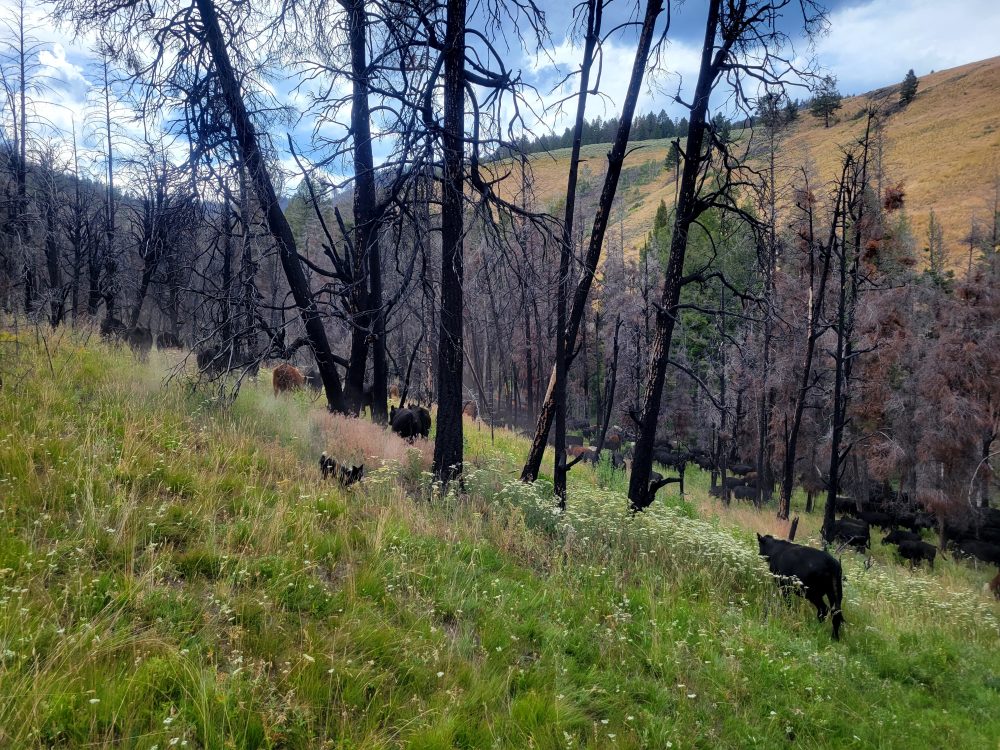
We’ve seen a lot of fire-blackened fir forest lately. This pic was taken a few weeks ago in the upper reaches of Big Hat Creek; Alderspring cattle work the green bounty.
There was a little grunting emanating from the ground where the more-than-a-little overweight form of James as he labored in the dirt and rocks. His snap button long sleeve western shirt was coming undone from his pants as he squatted on the dig. It wasn’t embarrassing yet, but it soon would be. The undertaking was obviously more than he intended to embark on, but then, in another moment, the digging motion with his pocketknife wielding hand stopped, and we watched as he gingerly extracted his prize: the entire plant, from stem to stern, from root to flower.
The centerpiece of the plant was obviously the cream-colored flower. But below that, some 5 inches into the soil substrate was a tiny flower bulb. It was about the size of a marble. The leaves were like thick leaves of grass; somewhat reminiscent of a garlic or onion.
James stood up and offered the entire presentation to his superior, Bill. “It’s a wild onion. They’re very good.”
Bill took the gift and eyed it carefully, and I leaned in at the same time. Indeed, it looked like an onion.
“Take a bite, Bill.” James implored.
“Are you sure it’s fine?” Bill asked.
“Oh yeah. It’s wild onion. We eat them out here in hunting camp all the time. They’re really quite good.”
Something wasn’t quite adding up in my head, although I didn’t know what. I searched for signs. Maybe it was the floral arrangement. Or maybe it was a little bit of body language, unspoken cues that I detected in James. He could be a crafty one. And this line of thought brought me some strange chills: It felt a little like I was witnessing the serpent offering forbidden fruit to Eve.
On the other hand Bill was up for the challenge. He broke the bulb off the stem, and knocked the excess dirt off, and took the marble-sized bulb between thumb and forefinger and raised it to his mouth.
In that moment–and none too soon, James reached up and strongly grabbed Bill’s wrist, halting the bulb’s trajectory into Bill’s digestive gateway.
Bill’s eyes flashed with surprise and perhaps a trace of anger.
In response, with a slightly twisted grin on his face, James simply stated two words: “Death camas.”
Bill dropped the bulb on the ground.
“Just one bite could kill ya.” And James was still smiling.
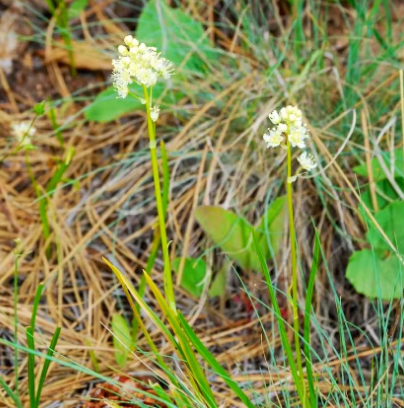
Death camas yields a beautiful flower. The simple, grass like leaves can get lost to the human eye in the grasslands they like to live in.
Four hundred and sixty head of black Angus beeves scattered on the Rocky Mountain foothill ahead of us. I was running flank this day on the back of the Palomino mare, Ruby. Beyond the cattle, the high crags of the snow-streaked Lemhi Range scratched the clouds at 11,000 feet.
This was good grass. It was the “hard grass” that the old-timer ranchers I had met spoke of. It was lush and green, and the diversity was an astoundingly high number; several hundred different plants could be found on these hillsides that we rode upon.
June marked the beginning of high summer in high country. Soil moisture was plentiful, and seeds and rootstocks in the ground had sprung to life after the snow left to in a hurry to take advantage of the short mountain growing season. It was sort of a race in the high peaks that occurred every year, and competition for growing space and water was fierce among the abundance of plants. For the most part, as a rancher, I was grateful for the expression of great diversity. It meant that our beeves had plenty of nutrition to choose from, and when that happened, they flourished in a picture of bovine health perfection. Their fly-free coats glistened in the sunshine, and they were free from any ill.
But there was one part of the plant equation that bothered me. It was the overwhelming presence of death camas or scientifically named Toxicoscordion venenosum (which even sounds quite deadly!). The plant was responsible for the highly predominating presence of cream-colored flowers on this very hillside. It was everywhere. It seemed like the highly poisonous plant could be found on every square foot of the mountainside.
I know that death camas kills cattle; it’s well documented. It is so toxic that Wikipedia notes that “The plant is visited by a specialist mining bee, Andrena astragali, possibly the only bee that can tolerate its toxins. Others are fatally poisoned.” Apparently, even the pollen is toxic.
Yet, we had never lost a cow to our knowledge. How can this be?
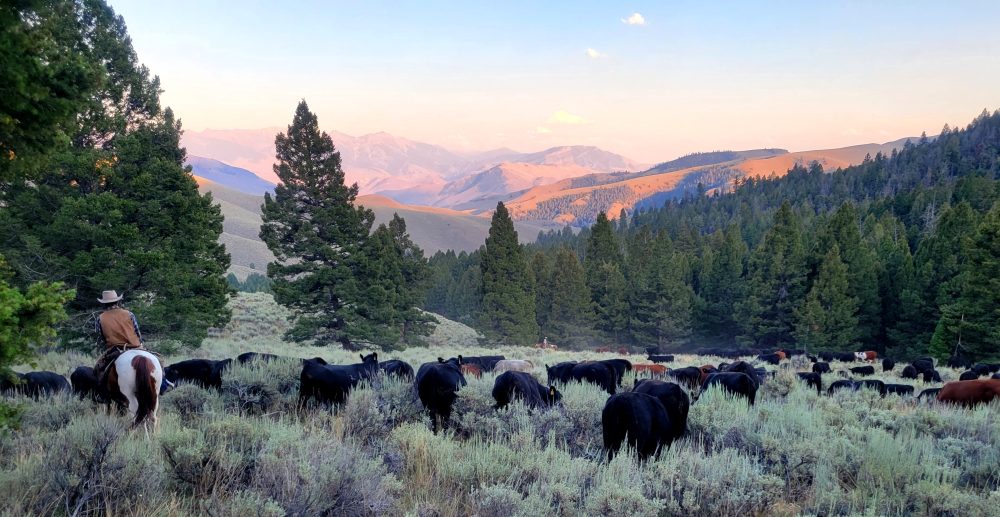
Josh rides drag on a herd that numbers over 400 head as the sun sets over the high Lemhi Range. In this thick sagebrush is abundant grass–and many death camas plants. Should we worry?
I wanted to learn more. And it just so happens that the bovine, or the humble domestic cow, is a very patient teacher. And I had the best seat in the class: horseback raises us up above the ground, and enables us to spy not only on what may be over the next horizon, but also, directly down to the ground, and observe an unsuspecting grazing cow from above (the cows are very comfortable with us nearby on horseback; not so much a two-legged human on the ground).
So on that day in death camas country, I watched and learned.
And what I saw from Ruby’s back astounded me. I saw cow after cow, literally hundreds of them, not eating death camas; it shattered the idea that dilution was the solution. Instead, it was complete abstinence. In thick grass, where a human could not have possibly delineated a difference, the humble cow ate the graminid or forb right next to the grass-like-leaves of Toxicoscordion, but bit not the bitter poison of said plant. I watched cow muzzles nudge and even push over bloom and leaf of camas to get the lush Idaho fescue (a grass) right next to it, but not ever ingest the leaves or flowers of death.
And they didn’t seem bothered by this incessant decision making. It was all in a grazing day’s work to the beeves. They got a wonderfully full belly of a richly diverse salad bar. As a human, I think I would get stressed out, carefully dancing through potential culinary poison day after day.
But the cow knows how.
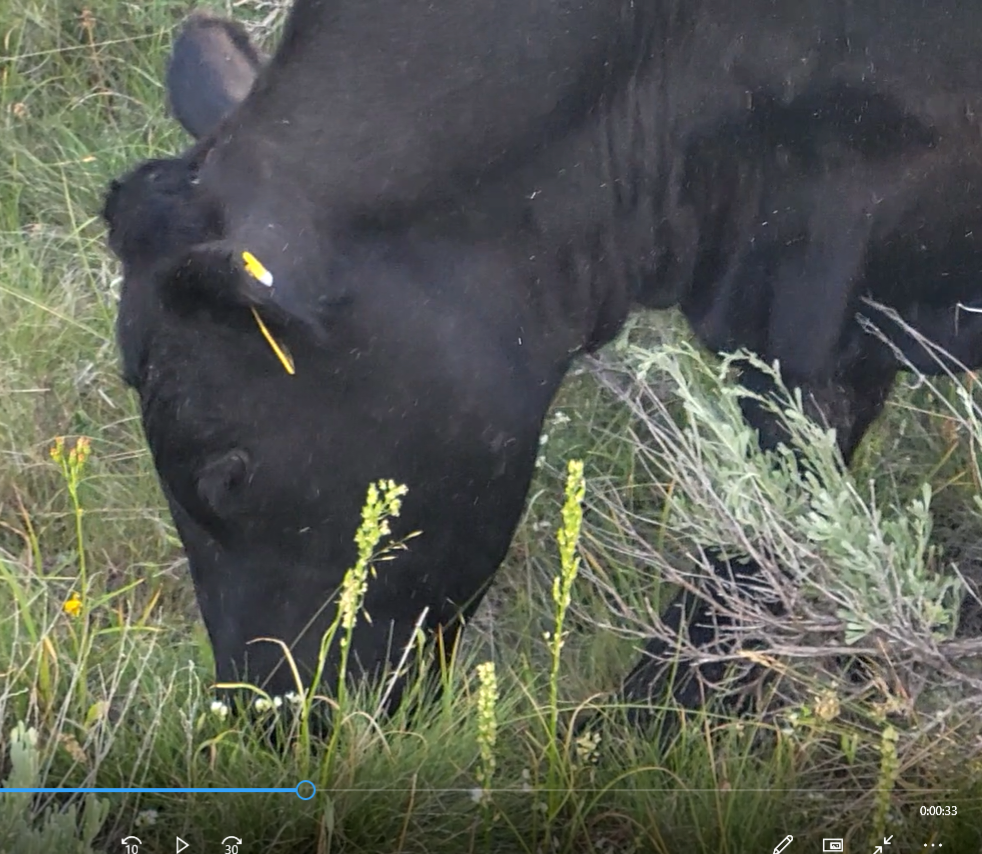
This Alderspring steer has got his head down, capturing the diverse green above camp Texarkana. I grabbed a video of him making his dietary choices, seeing if he at all swept up some death camas with his tongue…he did NOT. In this pic I can spot 4 definite grassy clusters of the camas (marked by their inflorescences gone to seed–the columnar cream colored stalks, all within tongue reach (it’s how they eat). But he knew where they were, and did not gather them.
So here’s the question that incessantly nags this rancher: Why does a cow know? How does he or she possibly know? Our friend Bill Helgemann knew not, and almost met his demise attempting to graze his snack-lunch offered by James Wilson on one fine summer day on the slopes of Ramsey Mountain.
We humans really have no idea.
But cows do. Who told them? Fact: about half of the cattle from Alderspring’s organic herd are raised as calves by friends of ours in Montana who don’t have death camas in their pastures. And then, we just put them up there on our summer grass ranges that have an entirely different species makeup than where they were raised. We don’t show them flash cards on plant ID or play Youtube video webinars about what to eat and what not to eat.
They simply know.
I had some friends from Bozeman, Montana on the ranch last week, and this discussion came up. When I asked them what their thoughts were on the “who told them” question, the gal immediately simply said, “God. God tells them.” For her there was no other explanation.
Her husband looked at her, dumbfounded.
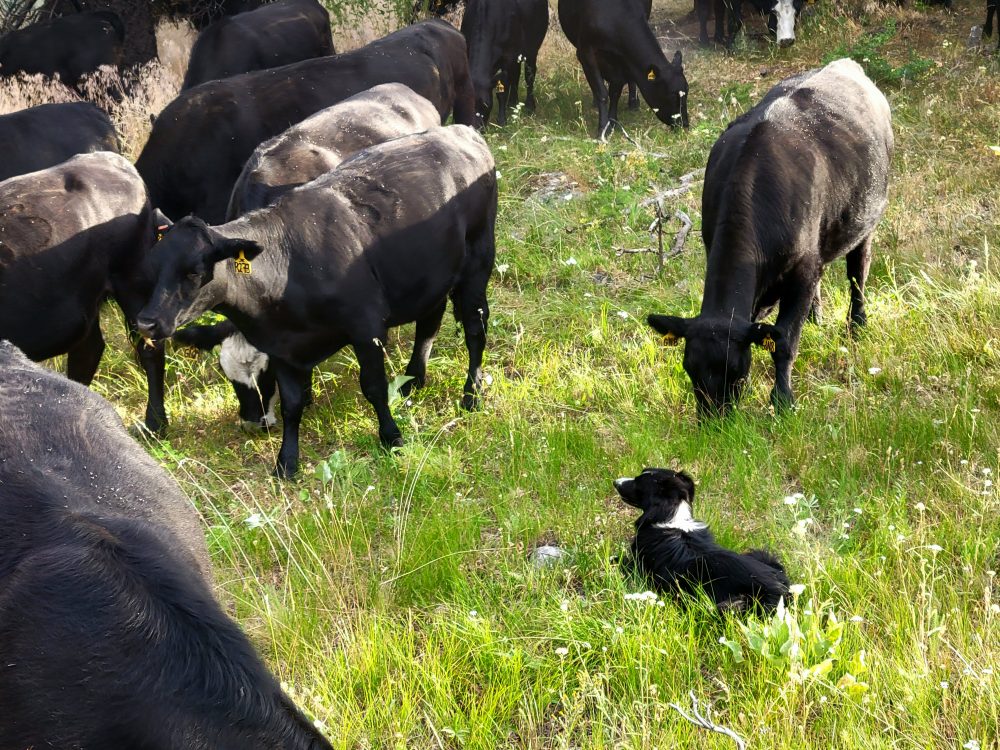
Here, Clyde the Border collie holds a piece of ground and prevents the beeves from grazing it. Perhaps he, too senses the possibility of death in camas? We’ll never know.
As far as the God explanation, I’m good with that. I don’t have any better explanations at the moment. And I now know and will always be impressed with just how smart cows are. I’m learning from them all the time. And I’m realizing that the largest size of the equation of knowledge about beeves is not what we know, but what we don’t know.
I’ll be standing in a rancher meeting, the coffee shop, or in the supermarket checkout line, and I’ll often hear the words “those stupid cows” in reference to the day they broke fence and got out, attacked the hired man, or died from camas or larkspur poisoning (another poisonous native which I will write about in a soon-to-come edition of this blog). And I’ll wonder if instead that the stupid ones may be us; those of the species Homo sapiens, who claim to know or perceive more than Bos taurus, the humble cow. Could it be that our knowledge or perception is not more or necessarily better, but different?
Happy Trails to you all.
-Glenn
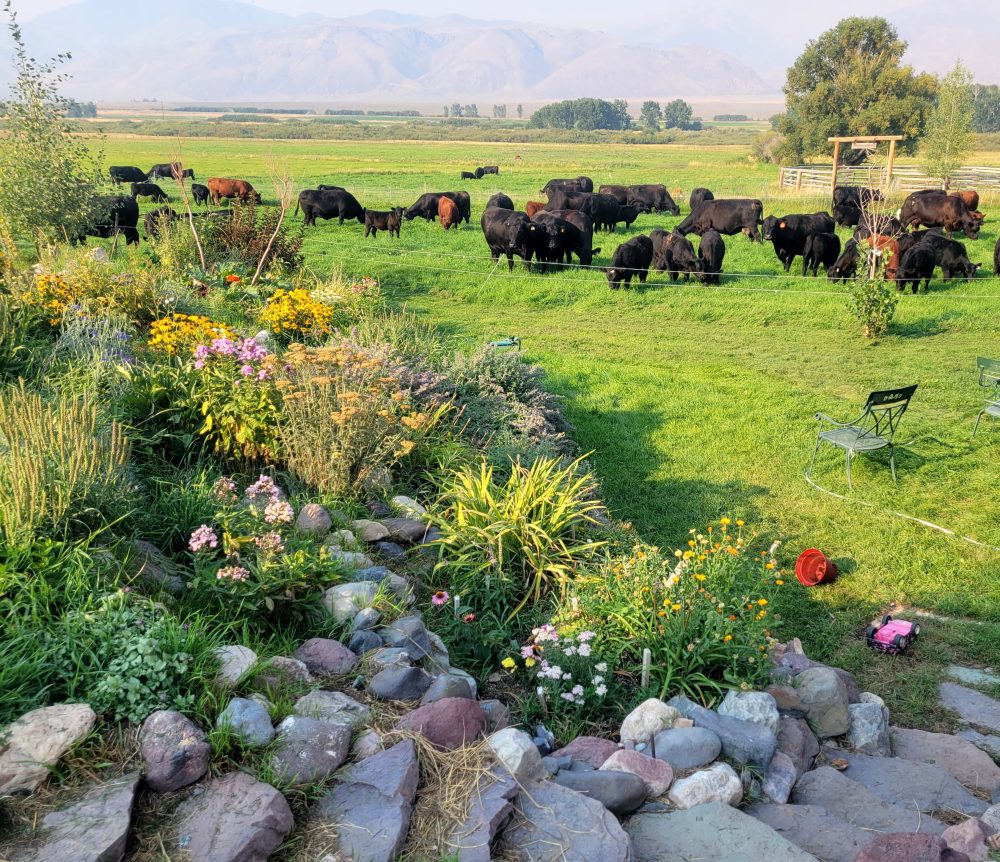
Those “stupid” cows. We had them in the backyard today. But it was intentional, as Glenn got tired of pushing the lawn mower. Even though they live a life out in the wild, they trust us because we live with them. And even our border collies know to leave them alone while they graze our back yard. Caryl was admittedly a little nervous because of her wildflower rock garden. Cows could decimate it, hence the temporary hot wire just beyond the lawn chair.

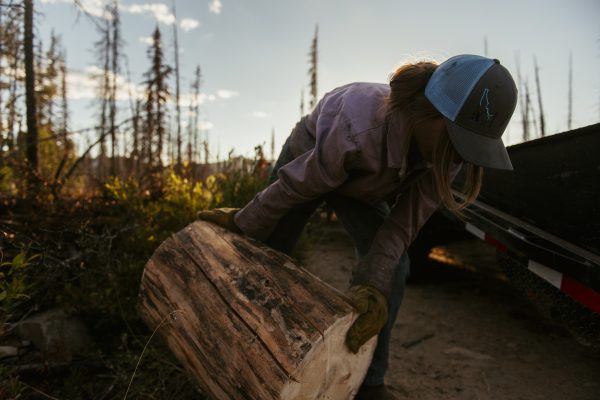
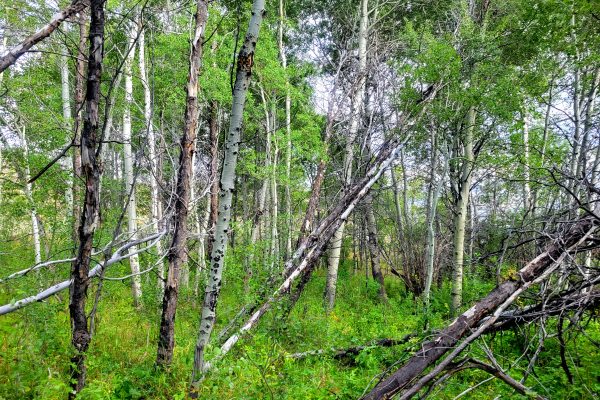
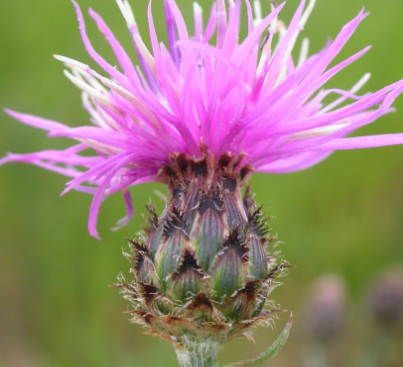
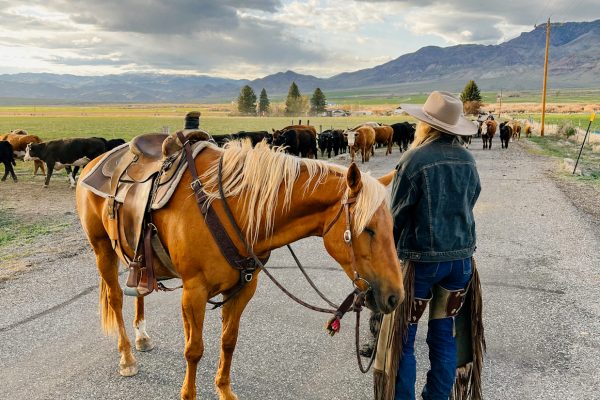


Jim Matthews
The “God” explanation IS the only explanation. The things that you see everyday are proof to me that there is a God even though there are some that would argue that point. If Heaven is anything like your ranch, I will be a happy man! That statement being somewhat presumptuous….
Caryl Elzinga
Thanks for reading Jim!
jeff z
Who told them?
Many would answer “mother nature.”
It is amazing that they have no problem believing in an imaginary “mother nature,” but refuse to acknowledge all the evidence of the loving intelligent design of our heavenly Father God.
Margaret
Amen Jeff.
Leo Younger
The stories about animals, such as squirrels, preferring non-GMO instead of GMO corn came to mind: https://organic.org/squirrels-prefer-organic-over-gmo-corn/ . A different search revealed info about the death camas and its bee: https://www.colorado.edu/asmagazine/2022/04/01/rare-relationship-between-death-camas-and-death-camas-miner-bees . The following link has several photos: https://www.richleighton.com/death-camas-americas-poisonous-native-lily/ . The best search results used simply the genus, Toxicoscordion, and there are surprisingly many species: https://en.wikipedia.org/wiki/Toxicoscordion . https://en.wikipedia.org/wiki/Toxicoscordion_venenosum may be the most widely distributed, and there are even maps if you hover over the distribution locations. Next link is from MSU (Montana State University) Extension Magazine: https://apps.msuextension.org/magazine/assets/docs/DeathCamas.pdf , wherein is mentioned an observation: “While death camas is generally non-palatable to livestock, a lack of other vegetation pushes them towards grazing available green forage.” The entire article is worthwhile reading. It seems that there are no known biological controls for eradication, other than humans who hand pull the plants. I guess that follows logically for a plant which is so poisonous that no organism, other than its friendly bee, can survive eating more than a small amount of any part of it. All of which brings to mind a question: why is it not more plentiful? There must be something which is limiting its proliferation. A link with many photos of many species follows: https://www.pacificbulbsociety.org/pbswiki/index.php/Toxicoscordion Just hover over any photo, and you’ll see a magnifier symbol. Click on your photo of choice, and click on the right arrow to scroll through all related photos.
Pamela K
Ooooo! Now I want to see more pictures of Caryl’s rock garden!
Love your blog. And I was finally able to make my first meat purchase. Delicious.
Caryl Elzinga
Pamela
It has gone just a tad wild. I love it, but she is a little freaked out with the success! Right now I think it looks like an alpine garden I’ve seen up in the high mountains above timberline! -Glenn